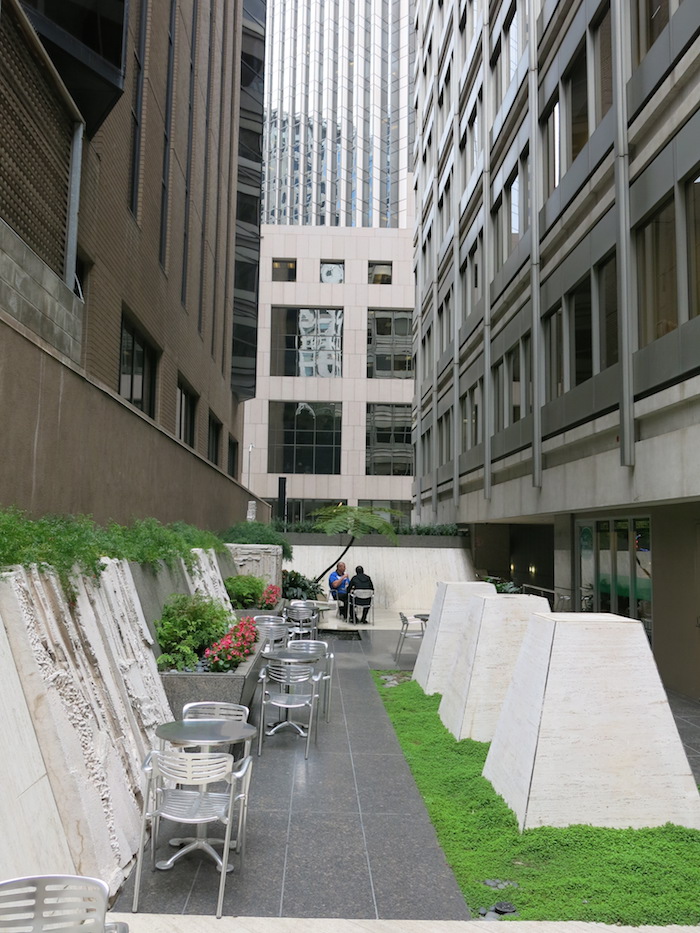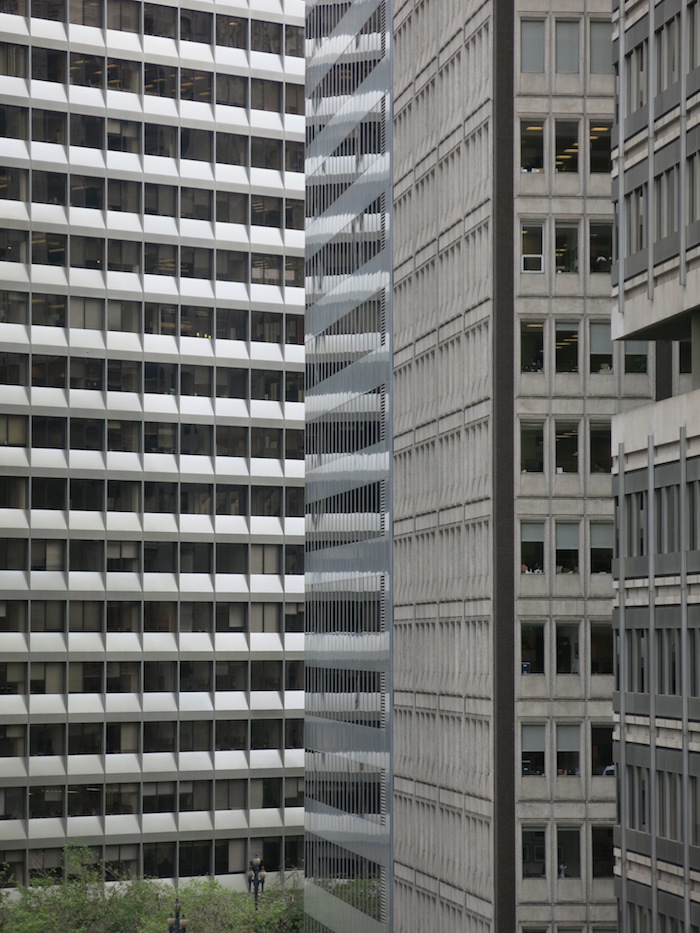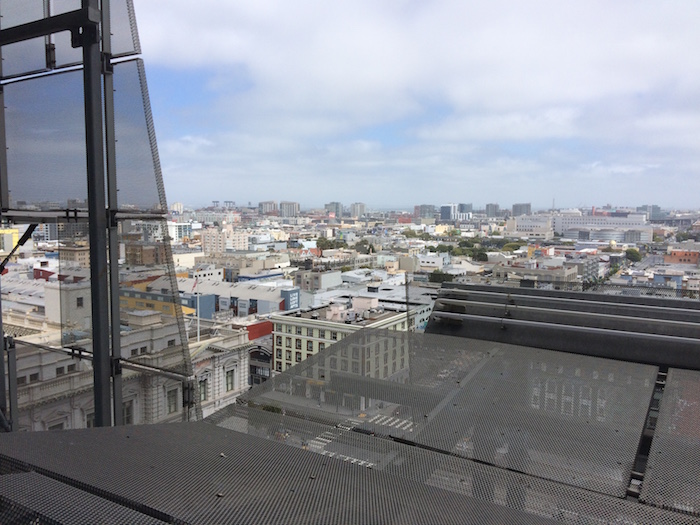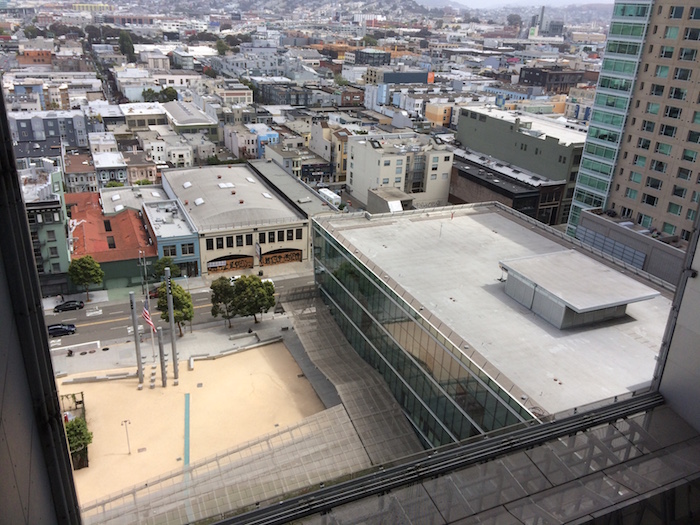Unless you know where to go, finding breathable, public open space in downtown San Francisco can be an aimless, wandering exercise. The financial district is dense, loud, currently in a monumental state of construction, and—with all this apocalyptic sunshine—beginning to feel more and more like a Manhattanized version of Hong Kong secretly courting Los Angeles.
Pedestrian flows, however, are mostly powered by tight-fit suits and plaid bow ties, millennial flourishes of corporate casual button-ups, tourists in cargo shorts, and outrageously glammed-up shoppers—all laced together on an outdoor catwalk-like treadmill shadowed by darting Ubers, hipster scooters, cyclists, and rattling delivery trucks. One wrong step and you'll end up in line for an overpriced bánh mì, or near a small planter boxed-in space sipping sculpted foam lattes while inhaling someone else's cigarette smoke.
 100 Pine St. POPOS | Nick Sowers
100 Pine St. POPOS | Nick SowersThe fact is there aren't many gems in the realm of “public open space” downtown. We have a few parks and plazas, but most of them are beyond the financial core's immediate sniffable boundaries, and more likely than not lead to shopping centers. It wasn't until the design of the Transamerica Tower in the late 1960s that planners got serious about providing more open space. So, what we have today, nestled in between all the towers (and occasionally on top, if you know where to look), are a glut of Privately Owned Public Open Spaces (POPOS) and parklets, threaded by improved alleys and beautified networks of security bollards. However, you wouldn't know most exist. The signs are easily missed. What became immediately clear to us once we began walking from one to the next, is that developers have no issue conceding those parcels to the public. But, where spaces remain cloistered (by design as a setback, up a stairwell, or within an interior or other less obvious location), there’s a definite effort to keep them concealed. Especially the rooftops. Aside from the most demonstrative publicly available sites, most are only used by workers in the vicinity, which is hardly surprising given the way the city continues to address its homeless crisis. The public zone here is a gradient of uncertain accesses and restricted quiets; a guessing game that might lead to a lunch date with a security guard.
In addition to how these POPOS constitute edges of private/public within the city as dispersed pixels of secret openness, what most intrigues us is how, from certain aerial vantages (on rooftops, raised terraces, and verandas), some present an acoustics of San Francisco’s vertical segregation. As the city continues to grow denser, the spatial politics of public and private become even more compounded by the insertion of condo towers and other skyward developments. We were curious to listen to the city's elevated fringes at their different planes of altitude, where the “private” is forced to give way for a moment to an informal tier system of token allotments of the “public.” There is, of course, no irony lost on this exchange: that while homeless nooks that have existed for decades are removed below, new crannies of micro-public are generated further up, but kept hidden.
We began at One Kearny Street, atop a small rooftop overlooking Market Street. Feeling a bit like a wingless pigeon perched on downtown’s shoulder, the soundtrack was punctuated by gardeners watering trees, and tupperware lids opening and closing from people on their lunch breaks. This would be the highest vantage we’d visit that day, and not only was it fascinating to hear all the street level activity somewhat buried from a distance, but we discovered a completely other soundtrack pulsing on the rooftop where there’s space left to move around and situate infrastructure. From there, we wound down through 101 California Street, a more vibrant open plaza patrolled by a security guard, and made our way up to the 6th floor of 150 California Street to listen to the chatter of financial strategists, birds’ nests, and mechanical droning on the sun terrace. We visited a couple of lower level spaces afterward, which often had the signature water fountain generating enough white noise to allude to a sense of privacy.

View from 150 California St. Sun Terrace | Nick Sowers
Our final stop, however, was the Federal Building, designed by Thom Mayne, just south of Market on 7th Street, the “greenest” federal building in the country. We didn’t notice any public signs nearby, and the TSA-like screening only proved that there can be a considerable sacrifice of time and privacy required in order to get to a “public” space at all. This was by far the most artificial as well. With views caged in by heavy metal meshes and barricades, the acoustics were an odd composite of birds, traffic, the echo of heavy doors opening and closing, footsteps on metal catwalks, and some unique phenomenon of sound brushing over undulating concrete. We probably felt more like caged monkeys in front of a secret zoo window than anything else.

View from Federal Building Public Space | Bryan Finoki
 View from Federal Building Public Space | Bryan Finoki
View from Federal Building Public Space | Bryan FinokiWhile not all of San Francisco’s POPOS are exclusive, for the most part it was only past glass turnstile doors, security checkpoints, up polished elevators, and under rooftop surveillance cameras that we became privileged to a slice of downtown quiet. If there is a hush of secret “public space” however, it’s certainly mixed with the spacious drones of rooftop air vents, vibing machinery, bleeping cellular tech, chirping plastic hawks, the slow roar of helicopters and jets, and the upward clamor of fire engine sirens ricocheting off the towers’ glass.
